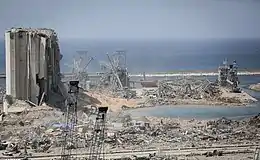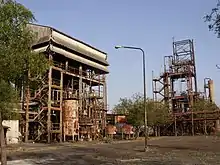Chemical accident
A chemical disaster is the unintentional release of one or more hazardous substances which could harm human health and the environment. Chemical hazards are systems where chemical accidents could occur under certain circumstances. Such events include fires, explosions, leakages or release of toxic or hazardous materials that can cause people illness, injury, or disability.

While chemical accidents may occur whenever toxic materials are stored, transported or used, the most severe are industrial accidents, involving major chemical manufacturing and storage facilities. The most dangerous chemical accident recorded in history was the 1984 Bhopal gas tragedy in India, in which more than 3,000 people had died after a highly toxic vapour, (methyl isocyanate), was released at a Union Carbide Pesticides factory.
Efforts to prevent accidents range from improved safety systems to fundamental changes in chemical use and manufacture, referred to as primary prevention or inherent safety.
In the United States, concern about chemical accidents after the Bhopal disaster led to the passage of the 1986 Emergency Planning and Community Right-to-Know Act. The EPCRA requires local emergency planning efforts throughout the country, including emergency notifications. The law also requires companies to make publicly available information about their storage of toxic chemicals. Based on such information, citizens can identify the vulnerable zones in which severe toxic releases could cause harm or even in some cases death.
In 1990, the Chemical Safety and Hazard Investigation Board was established by Congress, though the CSB did not become operational until 1998. The Board's mission is to determine the root causes of chemical accidents and issue safety recommendations to prevent future Safety Performance Indicators. It also organizes workshops on a number of issues related to preparing for, preventing, and responding to chemical accidents.[1]
In the European Union, incidents such as the Flixborough disaster and the Seveso disaster led to legislation such as the Seveso Directive and Seveso planning and provide for safety reports to local authorities. Many countries have organisations that can assist with substance risk assessment and emergency planning that is required by a wide variety of legislation, such as the National Chemical Emergency Centre in the UK, Brandweerinformatiecentrum voor gevaarlijke stoffen/Fire service information centre for dangerous goods in Belgium.
References
- "Chemical Accidents: About Archived May 31, 2008, at the Wayback Machine." OECD Environment Directorate. OECD. 19 July 2007.
External links
- 24-7 Response
- National Chemical Emergency Centre
- Brandweerinformatiecentrum voor gevaarlijke stoffen/Fire services information centre for dangerous goods
- Case Studies in Process Plant Accidents
- U.S. Chemical Safety and Hazard Investigation Board
- U.S. EPA, Chemical Emergency Preparedness and Prevention Office
- Safety in the use of Chemicals at work – International Labour Organization (ILO) – (PDF-file)
- MSDSonline.com A Searchable Database for Material Safety Data Sheets(MSDS)
- OECD Programme on Chemical Accidents: Environment Directorate
- National Institute for Occupational Safety and Health – Chemical Safety
- A searchable database for chemical safety accidents and lessons learned – FACTSOnline
- Preventing Chemical Accidents – How to Prevent Chemicals From Contaminating Your Workplace – Safety Storage Systems
